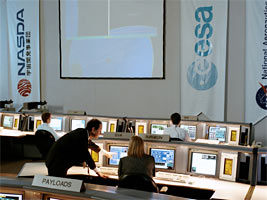|
In 1998,
when the first module of the new International Space Station
launched from the Baikonur cosmodrome in Kazakhstan, world
attention once again riveted towards space, this time to
witness a new beginning. Twenty-one flights into a 90-flight
assembly sequence as of this month, the ISS is already a
spacecraft of unprecedented capability for advancing the human
exploration of space.

A still image from an animation
of a completed International Space
Station.
Unlike
the first era of space flight that began with Yuri Gagarin's
flight in 1961, characterized by Cold War competition and "a
space race," this new era of space flight is heralded as the
age of the "International Astronautics and Cosmonautics." It
began on the eighth flight to the ISS, when Commander Bill
Shepherd, Soyuz Commander Yuri Gidzenko and Flight Engineer
Sergei Krikalev of Expedition One, opened the hatch to ISS on
Nov. 2, 2000. Human space flight is now characterized by
internationalism and partnership, with fresh approaches to
scientific research and commercialization. A future pathway
for space exploration and business is now being
enabled.

A view of the new Mission Control Center. The
new MCC features a workstation-based operating system
and an unprecedented flexibility in flight control
operations. The workstation-based system replaced the
obsolescent mainframe system used in the old Mission
Control, reducing maintenance costs and increasing
capability. The new MCC represents one of the world's
most extensive fiber optics data networks and uses
commercially available equipment common in today's
business world. |
Never
before had nations on Earth committed to such a monumental
engineering integration task whose scope and complexity
outstripped any previous efforts for earth orbiting stations.
With one million pounds of hardware under development in
locations throughout world, it took new forms of
intergovernmental agreements and Memorandums of Understanding
among five space agencies in the United States, Canada,
Europe, Japan and Russia, to lace together one huge
international team from 16 countries (Belgium, Brazil, Canada,
Denmark, France, Germany, Italy, Japan, the Netherlands,
Norway, Russia, Spain, Sweden, Switzerland, United Kingdom and
the United States) dedicated to building and operating a human
outpost in space, with permanent international presence,
poised for unknown challenges and discoveries. The legal
agreements meticulously outlined each Partner's contributions,
and share of common operating responsibilities, utilization
opportunities and crew time. Also unique to the ISS Program
were barter arrangements where partners could trade their
shares in these responsibilities across hardware, operations,
people and science.
For the
people working on ISS, it is also an unprecedented opportunity
to contribute to the security of the United States and the
world. Nations from around the world are working closely to
build and operate this enormously complex outpost in space.
They are doing so both from a desire to share in this destiny
together, and a need to rely on the expertise and resources of
each other's national wealth.
In what
many view as its greatest benefit, former Cold War adversaries
in the U.S. and Russia are now working together as partners,
colleagues and friends. This intimate interaction between
entire communities has done more to bridge fears and mistrust
between these peoples in the last eight years than the efforts
of diplomats over the last half-century. |





